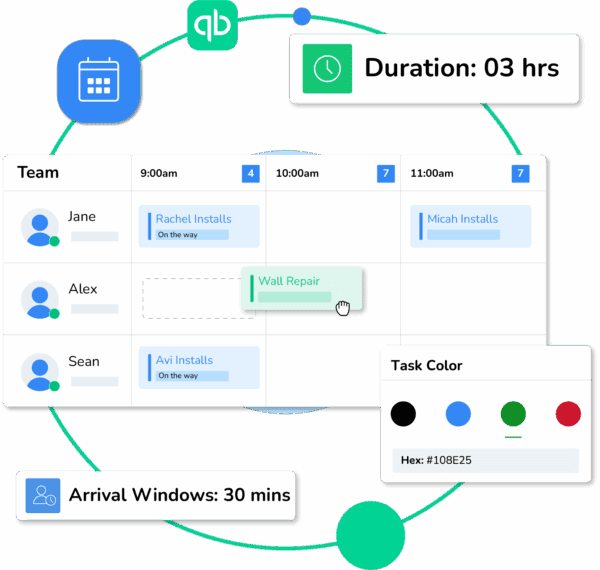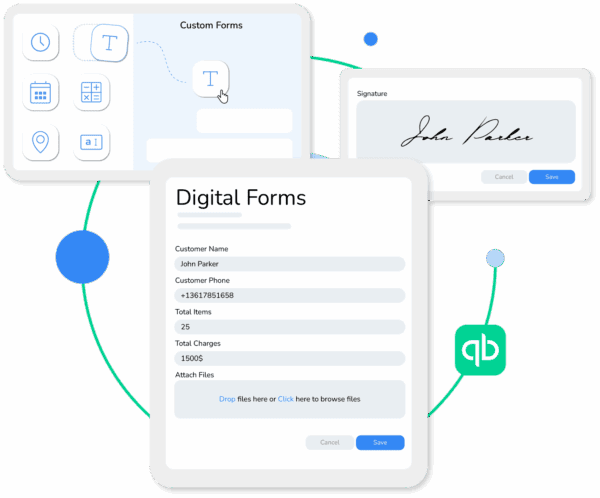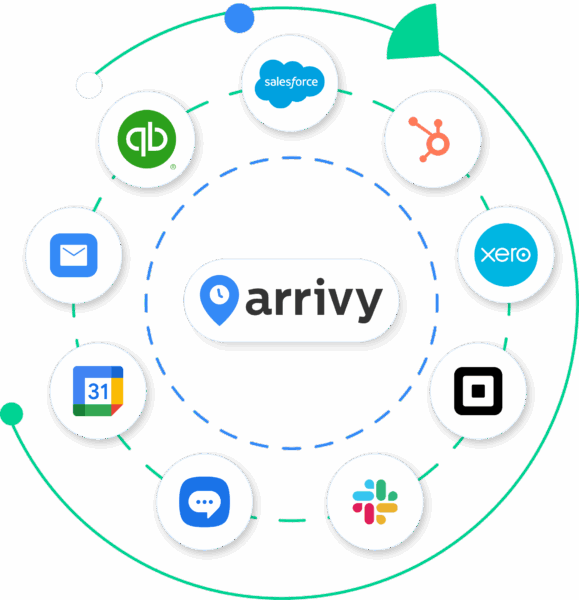
Your crews show up ready to work. They know their trade. Yet somehow, jobs run over budget and behind schedule. The problem lies in the broken systems surrounding your crews. U.S. contractors waste $30-40 billion every year because workers can’t work efficiently. Nearly half of construction firms saw their productivity get worse last year, despite having skilled crews and good equipment.
The real issue is information flow. When critical updates take hours to reach field crews, or when scheduling happens through scattered phone calls and spreadsheets, even your best workers become inefficient through no fault of their own.
This is exactly why field operations software like Arrivy exists. It eliminates the communication delays and coordination failures that waste hours every day. Your crews get real-time task updates on their phones, dispatchers see exactly where everyone is, and project progress flows automatically to your office systems.
Let’s take a deeper look at the problem, losses, solution, and ROI.
Recommended Reads
The Real Cost of Labor Inefficiency in Construction
Labor inefficiency happens when good workers can’t be productive because the systems supporting them are broken. In construction, this looks like crews standing around waiting for materials, supervisors hunting for the latest plans, or trades showing up when they can’t actually work because another trade isn’t finished yet.
The financial damage
Construction operates on thin margins, so inefficiency hits hard. Even small improvements matter enormously. Boost productivity by just 6-10% and you can raise profits by 2-3%. In many cases, companies see 50-100% jumps in profitability from fixing efficiency problems.
Example: Think about a $100,000 labor budget. If inefficiency wastes just 15% (a conservative number), that’s $15,000 gone. But the real damage goes deeper — you pay overtime to catch up, equipment rental runs longer, and the next job gets delayed. Those $15,000 in direct losses can become $30,000 in total costs.
Small contractors feel these losses in cashflow and margin, while large contractors feel the same percentage much more painfully in absolute dollars.
Did you know? Construction productivity has been essentially flat for decades. Between 2000 and 2022, productivity grew only 0.4% per year globally — while other industries became far more efficient.
Hidden costs that compound the problem
Project delays hit 87% of contractors. When your job runs late, you’re not just paying workers extra days. You’re also absorbing site management costs, equipment extensions, and potential penalties. Every delayed day pushes back your next project, creating a cascade effect.
Rework represents another killer. Poor information causes 48% of all construction rework. When miscommunication between field and office creates mistakes, you pay to fix the error plus overtime or temp workers to recover lost time.
Common Causes of Labor Inefficiency on Job Sites
Poor scheduling and crew coordination
Half of contractors say schedule management is their biggest challenge. Coordinating multiple trades, weather, and materials creates endless chances for crews to arrive at the wrong time or find nothing to do.
Consider a typical scenario. Electrical finishes early, but drywall isn’t available until next week. Meanwhile, plumbing sits idle because they need electrical done first. This way, poor coordination wastes hours across multiple trades and forces expensive schedule changes.
Trade coordination gets worse with subcontractors. One manager on Reddit described “scheduling conflicts where trades couldn’t completely finish and had to return once another trade completed different tasks.” This creates massive downtime and forces skilled workers to make multiple site trips.
“Scheduling conflicts where trades couldn’t completely finish and had to return once another trade completed different tasks.” — Construction Manager, Reddit
Communication breakdowns
Critical information takes too long to reach the people doing the work. Field crews wait for updates while office staff assume everyone has the latest information.
One experienced manager captured this perfectly: “The biggest issue is getting information to the people actually swinging the hammer. Everyone says ‘it’s in the system’ or ‘I emailed it,’ not realizing the actual crew doesn’t have proper communication tools.”
Key Insight: Miscommunication is one of the biggest causes of rework — fixing information flow is non-negotiable.
Manual paperwork delays
Many companies still use paper timecards, handwritten reports, and disconnected spreadsheets. This creates multiple efficiency drains:
- Time-filling forms
- Delays waiting for approvals
- Hours chasing missing paperwork
The burden hits supervisors hardest. When a site supervisor spends an hour each morning updating spreadsheets, that’s management time lost when they should be coordinating work and solving problems.
Resource mismanagement
When materials arrive late or equipment breaks down, crews stand around waiting. Unplanned equipment downtime consumes available labor hours in heavy construction.
Equipment problems create ripple effects. If your excavator breaks and you can’t quickly reschedule crews or get backup equipment, multiple trades face delays. Costs compound through extended rentals, overtime, and potential penalties.
Weather delays without tracking
Weather affects two-thirds of projects, but most contractors lack systems to track and respond efficiently to weather delays. Even planned downtime creates expensive ripple effects when you can’t quickly adjust and communicate changes.
Did you know? Weather-related delays silently inflate project costs through overtime and extended site management.
Smart contractors redeploy crews to indoor work or other projects, but this requires visibility and communication tools most firms lack.
How Arrivy Fixes Labor Inefficiency?
Arrivy is a field operations software built specifically for construction workflows. Instead of generic business tools that sort of work for construction, Arrivy understands how construction actually operates and provides features that directly solve coordination, communication, and tracking problems.
Smart scheduling that’s actually smart
Arrivy’s scheduling system gives dispatchers real-time visibility into where every crew is, what they’re working on, and when they’ll be available. Instead of phone calls and scattered spreadsheets, you see exactly what’s happening across all your jobs.
The system automatically accounts for travel time, crew skills, and equipment needs. When changes happen (early completion or unexpected delays), Arrivy instantly identifies affected crews and suggests optimal reassignments. This prevents skilled workers from sitting idle because nobody knew they were available.
Highlight: When your electrical crew finishes early, Arrivy immediately shows other sites needing electrical work and calculates travel times for the best next assignment. This real-time optimization recovers hours of productive time daily across your entire operation.
For small contractors, this turns early finishes into billable work by instantly matching nearby crews to the next job. While for large contractors, it balances crews, equipment, and travel across sites, so one delay doesn’t cascade through the entire day.

Real-time communication that reaches everyone
Arrivy bridges the communication gap with instant, two-way tools designed for construction workflows. Field crews update task status, request clarification, or report problems directly through the mobile App instead of playing phone tag or waiting for email responses.
The system automatically notifies relevant people when important things happen. When a crew marks a task complete, Arrivy simultaneously notifies the next trade, updates the project manager, and alerts the customer. This automated flow prevents delays from information bottlenecks and ensures everyone works with current information.
Office staff can instantly push updates, change orders, or new instructions to field crews, ensuring workers always have the latest information. This eliminates costly rework from crews continuing with outdated plans.
Mobile app that crews actually use
Arrivy’s mobile app eliminates paperwork delays and provides instant access to critical information. Crews view their daily tasks, including arrival windows, addresses, customer information, and job requirements, all from smartphones.
Task management becomes simple with an app that lets crews update status with button taps. “On Our Way,” “Task Started,” and “Task Completed” automatically trigger customer notifications and update tracking systems in real-time. This eliminates manual reporting delays and gives office staff immediate visibility.
Digital Forms for Accurate Documentation
Digital forms replace paper checklists and compliance documents. Crews complete safety inspections, quality checks, and progress reports directly on devices with photo capabilities, signature capture, and automatic integration with project systems. Teams can also get custom-built templates for data collection of their choice. This recovers hours of administrative work weekly.

Automated reporting and analytics
Arrivy captures labor data in real-time, eliminating manual time tracking and data entry that consumes administrative hours. Instead of morning spreadsheet updates or chasing missing timecards, project managers receive automatic reports on crew productivity, completion rates, and resource utilization.
Smart Outcome:
Analytics identify patterns and inefficiencies that aren’t obvious from daily operations. The system highlights crews that consistently finish early (possible underutilization), tasks that routinely take longer than estimated (process improvement opportunities), and weather or delay impacts on productivity.
This data-driven approach enables continuous improvement with objective metrics about what’s working and what isn’t. You make informed decisions about crew assignments, time estimates, and process changes based on actual performance data instead of gut feelings.
Complete integration with your business
Arrivy integrates seamlessly with existing systems, eliminating duplicate data entry and reducing administrative overhead. Time tracking flows automatically to payroll systems for accurate payment without manual timecard processing. Project progress updates trigger invoicing milestones, improving cash flow by reducing billing delays.
Compliance reporting becomes automatic when safety checklists and inspection data flow directly into compliance systems. This saves administrative time while reducing the risk of violations that can result in expensive penalties or work stoppages.

The ROI of Using Field Operations Software
The return on investment from a construction field service management software is measurable and often dramatic. McKinsey research shows focused digital transformation yields 14-15% higher productivity and 4-6% lower costs on construction projects.
Real-world results prove this works. One contractor reported that integrating mobile apps with project systems “saved hours every day” of manual data entry while markedly increasing crew productivity without additional labor costs.
Steps to Improve Labor Efficiency Today
Start with these practical steps you can take now to cut idle time, prevent rework, and get crews working more of the day on billable tasks. These steps deliver quick wins for small contractors and create the standards and visibility larger firms need.
Audit current workflows
Document exactly how work flows through your organization from initial scheduling through completion. Track where delays occur, identify communication bottlenecks, and measure the time crews spend on non-productive activities like waiting for information.
Pay attention to handoffs between trades, approval processes, and reporting requirements. These transitions often reveal the greatest improvement opportunities.
Identify communication gaps
Map current communication flows to find where important information gets delayed or lost. Common problems include change order communication, daily progress updates, and problem escalation processes.
Look specifically at subcontractor communication. Many efficiency problems stem from information not reaching workers actually performing tasks.
Start with Arrivy
Choose Arrivy because it’s designed specifically for construction workflows rather than generic business software adapted for construction. Start with core functionality like task management and crew communication, then gradually add features like digital forms and advanced analytics. This phased approach lets your team adapt without overwhelming them with too many changes at once.
Measure progress
Establish baseline measurements before implementing Arrivy, then track improvement over time. Focus on labor productivity (hours per completed task), project completion rates, customer satisfaction, and rework percentages.
Track leading indicators that predict problems before they become expensive, like communication response times, task completion rates, and crew utilization. Regular measurement demonstrates ROI and identifies opportunities for continuous improvement.
Conclusion
Labor inefficiency is bleeding your business of profit, while competitors who fix these problems gain significant advantages. The solution isn’t more workers or longer hours. It’s Arrivy’s field operations platform that eliminates coordination failures, communication breakdowns, and administrative inefficiencies, preventing your skilled crews from delivering full potential.
Stop Losing Hours to Miscommunication.
Frequently Asked Question
Field operations software is a digital platform designed specifically for construction workflows that includes a mobile app for crew task management, real-time communication between field and office, automated scheduling and dispatching, digital forms and checklists, GPS tracking, and integration with business systems like payroll and project management.
Modern construction companies use field operations software like Arrivy to automatically track labor productivity through mobile time tracking, task completion rates, crew utilization percentages, and real-time progress reporting. This eliminates manual timecard processing and provides objective data for measuring and improving efficiency.
Yes, field operations software like Arrivy significantly reduces both overtime and rework. Better coordination and communication prevent the delays that force overtime work, while real-time access to current plans and specifications eliminates the miscommunication.
Key performance indicators include labor productivity (hours per completed task), project completion rates, crew utilization percentages, rework rates, communication response times, customer satisfaction scores, and safety incident rates. Focus on leading indicators that predict problems before they become expensive delays or rework.
Absolutely. Small contractors often see the fastest ROI because they have fewer complex processes and can implement changes quickly. Studies show that improving labor productivity by just 6-10% can raise profits by 2-3%, and in many cases deliver 50-100% improvement in overall profitability. Even modest efficiency gains quickly justify the software investment.
